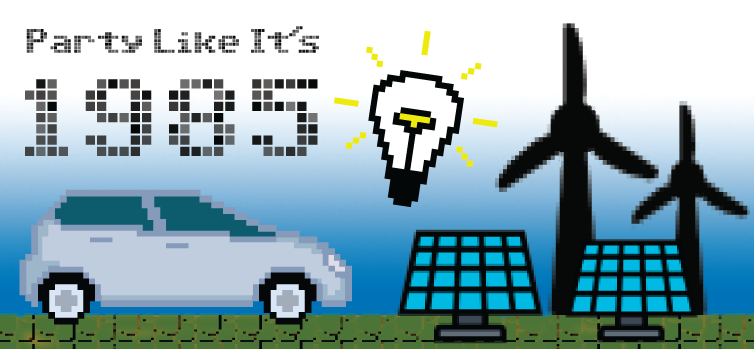The mini Nintendo Classic has everyone partying like it’s 1985 again. Yes, technology has certainly come a long way in 30 years. Take clean energ...
Office of Critical Minerals and Energy Innovation
December 21, 2016
The mini Nintendo Classic has everyone partying like it’s1985 again. The vintage video game console is the one of the hottest gifts this holiday season, as thousands of consumers are scrambling to get their hands back on this bit of nostalgia. The mini Nintendo is a replica of the original 8-bit system that debuted in the United States in 1985 and had just one-eighth of the processing power of today’s iPhone.
Yes, technology has certainly come a long way in 30 years. Take clean energy for example. We’re currently in the midst of a revolution that has seen costs for wind and solar technologies, electric vehicles (EVs), and light-emitting diodes (LEDs) drop by as much as 94% since 2008. As a result, deployment has increased with solar photovoltaic (PV) and wind energy accounting for more than two-thirds of all new, U.S.-installed electricity capacity in 2015; LED A-type bulb installations total more than 200 million nationwide; and the United States is now a world leader when it comes to EVs, with more than 500,000 vehicles on the road.
[[{"type":"media","view_mode":"media_energy_gov_wysiwyg_fullwidth","fid":"1136653","field_deltas":{},"link_text":null,"attributes":{"alt":"RevNow2016 total.png","title":"Revolution...Now 2016 Update Report","height":322,"width":1000,"style":"width: 1000px; height: 322px;","class":"media-image caption media-element file-media-energy-gov-wysiwyg-fullwidth","data-delta":"1"},"fields":{}}]]
So, just how far have we come since 1985? The charts below show the incredible progress we’ve made through three decades worth of investments in the research, development and deployment of these thriving technologies today.
[[{"type":"media","view_mode":"media_energy_gov_wysiwyg_fullwidth","fid":"1136657","field_deltas":{},"link_text":null,"attributes":{"alt":"Solar-01.png","title":"Graphic by Sarah Harman","height":463,"width":1000,"style":"width: 1000px; height: 463px;","class":"media-image caption media-element file-media-energy-gov-wysiwyg-fullwidth","data-delta":"2"},"fields":{}}]]
PV solar cells were widely used in space missions in the early 1970s, but distributed and utility-scale PV did not catch on commercially until the early 2000s. The average selling price of a PV module has decreased by 97% since 1985. During this time, utility-scale PV projects have grown from zero to more than 1,700 in the United States.
[[{"type":"media","view_mode":"media_energy_gov_wysiwyg_fullwidth","fid":"1136665","field_deltas":{},"link_text":null,"attributes":{"alt":"Wind-01.png","title":"Graphic by Sarah Harman","height":463,"width":1000,"style":"width: 1000px; height: 463px;","class":"media-image caption media-element file-media-energy-gov-wysiwyg-fullwidth","data-delta":"3"},"fields":{}}]]
Although people have been harnessing wind to do work for centuries, the first utility-scale wind farm wasn’t installed in the United States until 1980. Five years later, wind’s cumulative U.S. capacity was just 0.348 gigawatts. That has grown to nearly 74 gigawatts in 2015 – enough to power more than 17 million U.S. households.
[[{"type":"media","view_mode":"media_energy_gov_wysiwyg_fullwidth","fid":"1136669","field_deltas":{},"link_text":null,"attributes":{"alt":"LEDs-01.png","title":"Graphic by Sarah Harman","height":463,"width":1000,"style":"width: 1000px; height: 463px;","class":"media-image caption media-element file-media-energy-gov-wysiwyg-fullwidth","data-delta":"4"},"fields":{}}]]
Perhaps there is no greater success story than that of the LED A-type bulb. They didn’t even exist in 1985! At the time, incandescent bulbs dominated the market, with the first compact fluorescent light bulbs just starting to emerge. LEDs were used in niche products such as pocket calculators in the 1980s and didn’t show up as a viable bulb until 2006. Now, LEDs account for 6% of all currently installed A-type bulbs in the United States.
[[{"type":"media","view_mode":"media_energy_gov_wysiwyg_fullwidth","fid":"1136673","field_deltas":{},"link_text":null,"attributes":{"alt":"EVs-01.png","title":"Graphic by Sarah Harman","height":463,"width":1000,"style":"width: 1000px; height: 463px;","class":"media-image caption media-element file-media-energy-gov-wysiwyg-fullwidth","data-delta":"5"},"fields":{}}]]
The development of lower-cost, lithium-ion batteries has helped make the United States a world leader in the EV market. The Energy Department estimates that the cost of EV batteries, produced at high volume, has fallen by 73% since 2009. Lithium-ion batteries did not debut in the United States until the early 1990s. Energy Department-funded research into this technology began in 1992.

